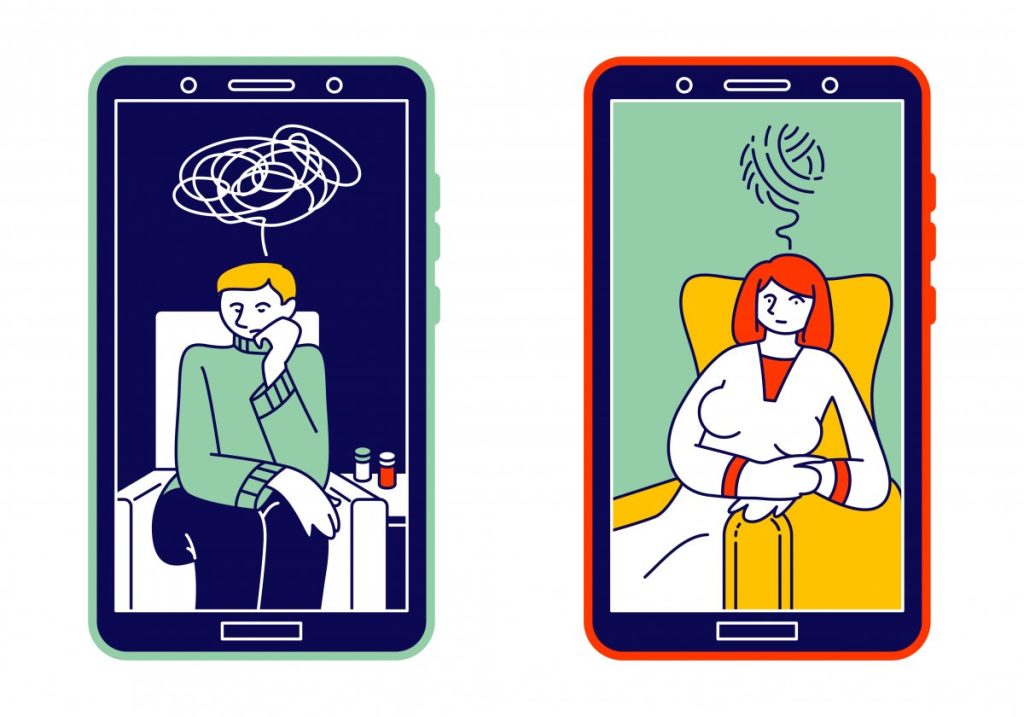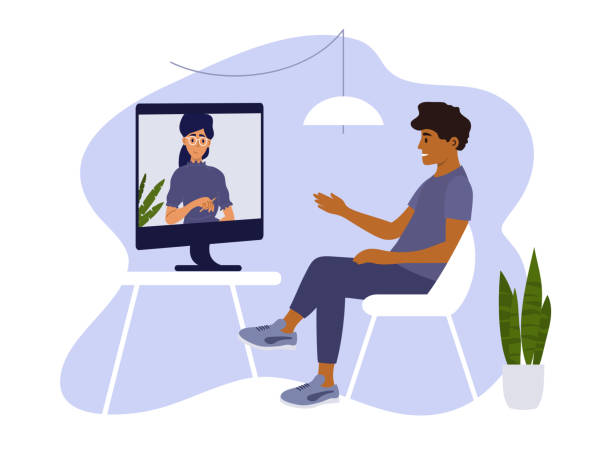[vc_row][vc_column][vc_column_text]“Finding a therapist was on my to-do list for many, many years, but I never got around to it,” says Courtney, a Toronto-based communications professional. “I just found the act—of finding a therapist, going to appointments, that sort of thing—overwhelming.” During the COVID-19 pandemic, as virtually all therapists moved their practice online, she finally signed up for her first-ever appointment with an online therapist, meeting on Zoom with a practitioner that a friend recommended whose scheduling was done via text and accepted payment via e-transfer.
Courtney met with the therapist three times over several weeks and found the process simple and straightforward. “For me, the experience was great and I will do it again,” she says. “She sent me a Zoom link, and I just set up in my living room on a table that was at the right height. It was extremely comfortable.”
Ultimately, there wasn’t a perfect fit, and Courtney is still looking for the right mental health practitioner for her needs. But the experience of accessing therapy virtually was game-changing, and Courtney says she expects to continue her journey online. “I’m sure there are lots of people who will want to see someone in person and there’s a market for that,” she says. “But, to me, what a dream to be able to do it from your living room—it’s the difference between spending 45 minutes or spending at least three hours with travel time.”
The past two years have been tough on many of us. In fact, a fall 2020 survey from Statistics Canada found that almost one in five Canadians aged 12 and older reported a need for mental health care in the past year. Among that group—75 percent of whom indicated they needed counselling or therapy—less than half felt that their need for care was fully met, due to factors like “a lack of knowledge as to where to get help,” “care not being readily available,” and “not being able to get around to get help.”

There may be different barriers preventing access to mental health care for Canadians, but something that can help is the widespread adoption and availability of virtual therapy since March 2020.
Prior to the pandemic, counselling and therapy were primarily offered as face-to-face services in an office setting, says Kathy Offet-Gartner, the president of the Canadian Counselling and Psychotherapy Association (CCPA) and a counsellor at Mount Royal University. “It’s not that it wasn’t available, [but] it wasn’t the norm.” There were ethical and practical concerns about online healthcare, and the therapist’s ability to confirm things like the client’s identity, security and privacy during the session.
But when everything was forced to go online at the start of the COVID-19 pandemic, therapists, like many other healthcare providers, found ways to resolve many of these challenges, developing new competencies and guidelines to help guide the switch from in-person to online.
And now, even though in-person appointments are available again, online therapy remains very popular with both therapists and clients. “I have practised completely virtually for the past two years…and I love it,” says Offet-Gartner.
RELATED: Why Virtual Therapy is Here to Stay (And What To Expect At Your First Appointment)
Across the country, there are many remote therapy options that are accessible from anywhere with internet or phone service, making it easier and more convenient for more of us to find and get care. “It has opened up an entirety of service providers and service avenues that weren’t possible before, and I think that’s critical for those individuals who live in really remote or isolated communities,” says Offet-Gartner, noting that some First Nations, Inuit and Métis had to leave their community, and in some cases travel quite far, to find a therapist who was a fit for them. “[Now] they just have to dial-up and click a link, and they’re immediately there.”
Online therapy has also made it easier for individuals with busy schedules to fit appointments into their days. “It’s reduced barriers in terms of transportation and time,” says Offet-Gartner. “If you have a one-hour appointment, you can stop and start in one hour because there’s no travel time. You don’t have to drive anywhere, you don’t have to park anywhere, you don’t have to arrange childcare.”
Here’s what you should know about accessing therapy online, and expert advice on how you can find the right therapist for your needs.
What are the different types of therapy that are available?
The Centre for Addiction and Mental Health (CAMH) describes psychotherapy as “a general term used to describe a form of treatment that is based on ‘talking work’ done with a therapist” to “relieve distress by discussing and expressing feelings; to help change attitudes, behaviour, and habits that may be unhelpful; and to promote more constructive and adaptive ways of coping.” Online therapy can be via email, chat, or audio or video calls.
Therapy can be offered by psychiatrists, psychologists, social workers, registered psychotherapists and even some family doctors. “A psychiatrist is a medical doctor who specializes in mental health, especially mental illness…[And] because they are medical doctors, they have prescribing rights,” says Offet-Gartner. “A psychologist deals with mental health more frequently than illness.” There are many different types of psychologists, but you would typically see a counselling psychologist for mental health and well-being issues, says Offet-Gartner.
“Psychiatrists and family doctors can diagnose and prescribe medication. Psychologists can diagnose, but they cannot prescribe. Social workers and registered psychotherapists actually engage in the therapy with you,” says Megan Rafuse, a registered social worker and clinical therapist on Maple and CEO of Shift Collab.

How much does therapy cost?
Provincial and territorial health plans cover appointments with a psychiatrist, but you’ll need a referral from your family doctor. There are clinics and community health centres that offer a variety of free and low-cost counselling services, and the extended health benefit plans offered by some employers may cover therapy.
Social workers, psychologists and registered psychotherapists can set their own rates, which vary widely depending on their training, expertise and location, although some do offer sliding-scale fees for low-income clients. In contrast, virtual care providers will often charge set fees for an appointment, regardless of the specific practitioner. With Maple, for example, every 50-minute psychotherapy session is $120 whether you’re seeing a registered social worker (MSW RSW) or registered psychotherapist (RP).
Where do I find an online therapist?
Offet-Gartner recommends asking for personal recommendations and looking at therapists’ online profiles and websites. Consider if they would be someone that you would want to see, and reach out via email to find out their philosophy of counselling, their specializations, and the kinds of services they provide. “Clients need to feel empowered and emboldened to ask questions,” she says.
The Canadian Counseling and Psychotherapy Association has a directory on its website where you can find a Canadian Certified Counsellor (CCC) for counselling or psychotherapy services simply by inputting details like your location and preferred language.
With the “Find a Therapist” tool on the Psychology Today website, you can browse through profiles of a range of therapists by location—including counsellors, psychologists, social workers and psychotherapists—and filter by criteria like type of therapy, language and insurance if you want.
Don’t worry so much about finding a therapist that is close to you, although they do have to be licensed to practice in your province or territory of residence. The right online therapist may be down the street from you, or hundreds of kilometres away. Physical proximity can benefit your relationship with a therapist, but it could also be a deterrent in certain situations, notes Offet-Gartner. “I think about people in small communities that maybe don’t want to bump into their counsellor at the grocery store or at church,” she says. “It’s really important that you have the opportunity to be able to be anonymous.”


How do I find the right therapist?
With Maple, you can request to book an appointment with the first available practitioner. Or you can also choose a therapist that meets your needs by browsing their bios to review credentials and areas of expertise and learn more about them. And if you’re still not sure, there is a care navigator tool that can help match you with a practitioner. “Our goal is…to help you find the right fit for you,” says Rafuse. “Because we know that the people who have the best outcomes in therapy feel really connected and have a strong rapport with their clinician.”
When you meet with an online therapist, find out if they’ve worked with clients who have similar challenges as you, and consider whether they are someone that can help you meet your goals, suggests Rafuse. “Different therapists have different specialities, and you don’t have to stick with a therapist that doesn’t feel like the right fit for you,” she says. “It’s okay to switch therapists.”
It’s also important to follow your instincts. “Pay attention to how you feel in the session,” says Rafuse. “We are going to feel a little nervous talking to someone new, but if your impression is, ‘This doesn’t feel good,’ or, ‘If I saw this person on the street, I really wouldn’t even want to have a conversation with them,’ that’s probably not the therapist for you.”


What should I know before my first session?
To get the most out of your virtual appointment, do try to sign on from a private location where you won’t be distracted or interrupted. “It’s still a counselling session, and counselling is work,” says Offet-Gartner. “You are exploring and being vulnerable. You still need to make sure that you have the support that you need to be able to engage in a vulnerable experience.” And because the appointment is not in an office setting, you can also take steps to make your environment more comfortable, whether that’s having a pet or favourite memento nearby, playing music softly in the background, or burning essential oils in the room.
You may want to discuss your preferences and learning style with the online therapist, too. “Are you somebody who wants to show up for an hour, do the work in session and then be on with your week and have no homework? Or are you someone who prefers to have activities related to therapy you can do throughout the week, and then have your session and follow up,” asks Rafuse. “Our clinicians will work with clients based on what their preferences are, recognizing that no two people are the same. And we use a number of therapeutic modalities that are evidence- and research-based, to help you to move through your challenge.”
[yikes-mailchimp form=”1″ title=”1″ submit=”SUBSCRIBE”][/vc_column_text][/vc_column][/vc_row]














